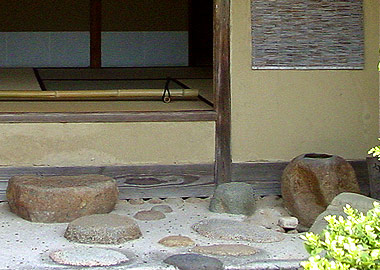| Also kaname-ishi vÎ. Rocks and stones which in a tea garden *roji In which served a practical as well as an aesthetic purpose. Many of these stones helped guide guests through the garden or highlight key design features. Yaku-ishi were named according to their position or function. Directly in front of the low entrance *nijiriguchi çWû to a rustic tearoom *chashitsu º were the first stone *hatsu-no-ishi ÌÎ or stepping stone *fumi-ishi ¥Î, the second stone *niban-ishi ñÔÎ or falling stone *ochi-ishi Î, and the third stone sanban-ishi OÔÎ or mounting stone *nori-ishi æÎ. A hot-water bucket stone *yuoke-ishi ±Î with a bucket of water placed on it for guests, was located beside the handwash basin *chouzubachi è
«. The front stone *mae-ishi OÎ was placed directly in front of the basin, and opposite the water bucket was the candle-holding or lantern stone teshoku-ishi èCÎ. Other yaku-ishi included a sword-resting stone *katanakake-ishi |Î below the sword rack *katanakake |, a viewing stone *monomi-ishi ¨©Î, a general guest's stone *kinin-ishi MlÎ and listening to a bell stone kanekiki-ishi à·Î near the waiting arbor *koshikake machiai |Ò, and a path-dividing stone *fumiwake-ishi ¥ªÎ and temple stone *garan-ishi ¾Î. There were also stones near the middle garden gate *chuumon å called the step-over stone *norigoe-ishi æzÎ, guest stone *kyaku-ishi qÎ, host's stone teishu-ishi àåÎ, and under-the-door stone tozuri-ishi Ë Î. Seven yaku-ishi were known collectively as the seven trump stones *nanatsu-ishi µÂÎ. |
